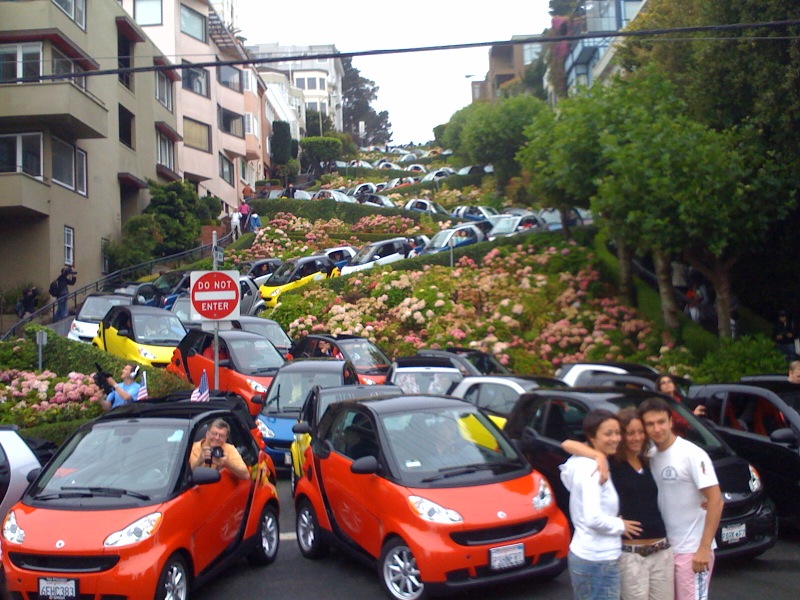Why City Cars Don’t Work

“City cars,” ranging from the Smart to the Honda Fit (and equivalent subcompacts), are intended for use in urban areas. Their popularity has steadily risen in Europe and Japan, thanks to highly developed rail systems and high vehicle ownership costs. Manufacturers have been pleading with the American consumer to accept these city cars for years now. Only minor changes are needed to legalize these cars for sale in the USA. That allows manufacturers to take advantage of the economy of scale, all while adding to the bottom line.
The problem is, though, city cars are one trick pony’s and will never catch on in present-day America. Why?
I love to get behind the wheel for hours at a time, and much of the country feels the same way – Americans drive an average of 15,000 miles a year, compared to 9000 for the British and a mere 5000-8000 for the Japanese. Cars and road trips are an American tradition. It is the ultimate way to see the country in comfort, in lieu of having to put up with airport delays and rude kids. A quiet, spacious, adequately powered, smooth riding car will make the experience that much more luxurious – and I’ve just listed everything that city cars are missing! They are the opposite of everything a good American cruiser should be.
The first strike against city cars is simple: they have to be tiny. They are designed to be easy to park in a dense metropolis, so they cram passengers and their belongings into an uncomfortably tiny bubble. Worse, since they were designed for overseas markets, their seats are not designed to comfortably fit the average American. Even if the manufacturer reshapes the seat to accommodate Americans, they simply can’t fix the shortage of human and luggage space. Finally, if I had to be a crash test dummy in a city car vs. family sedan head-on impact, I’m pretty sure no amount of alcohol would convince me to pick the city car.
The tradeoff is not worth it. I frequently drive my truck to San Francisco, Los Angeles, and Las Vegas. I’ve driven through the downtowns and back roads of New York City, Kuala Lumpur, and Singapore with 7-seat vans and SUVs. I don’t consider myself a great driver, but I’ve never had an issue with maneuverability or parking in any city. It’s simply unfathomable that car buyers would accept such compromises to allow for easier maneuvering and parking.
Not only do city cars force you to squeeze into a tiny space for nothing, but they also actively beat you up! By the laws of physics, cars with a shorter wheelbase (distance between front and rear wheels) generally ride rougher. By the laws of humans, city cars need to sip gas – and as such, are woefully underpowered when faced with anything larger than a pitchers mound. By the laws of engineering, city cars need to be light so they don’t place a larger burden on their tiny engines. Leaving out sound insulation is almost universally the preferred weight reduction method. This trifecta of laws has resulted in cars that are rough riding, underpowered, and excessively loud. Suddenly, air travel is starting to look mighty attractive…
The final nail in the tire is that for all their shortcomings, city cars often struggle to match the highway gas mileage of their larger siblings:
- The non-hybrid, non-sport Honda Civic is larger and more powerful than the Honda Fit, and yet manages better fuel economy across the board. The Civic is rated for nearly 25% better fuel economy in the most dramatic case.
- Toyota is the only manufacturer where the subcompact has better fuel economy – the Yaris manages 1MPG better than a similar Corolla.
- At Hyundai, the Accent subcompact and Elantra compact both get the same highway mileage.
- The Ford Fiesta and Focus both get identical highway mileage with automatic transmissions, with or without the SFE package.
- The Chevy Cruze gets 1-7MPG better highway fuel economy than the dated Aveo.
The 100,000 folks a year who buy city cars will inevitably argue about better resale value or pricing, which is invalid. Even without considering the gas money you’d save by buying a Civic over a Fit, there isn’t a dramatic price jump for buying the larger car. Plus, the extra money you pay now is recovered when you sell it. The Fit may be cheaper to buy today, but also won’t fetch as much 5 years later. There is simply no advantage to them. If parking or driving in a city is so hard for you that you happily accept these tradeoffs in a car, please take the bus! Pedestrians and fellow drivers will thank you.

